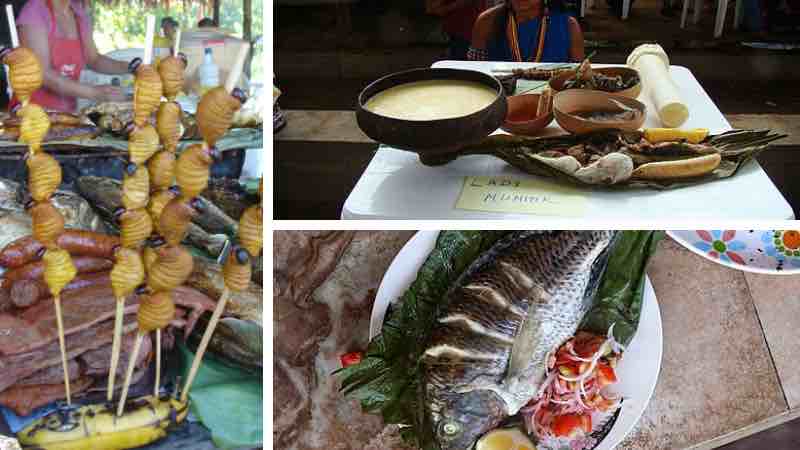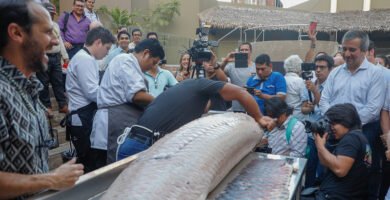
Geographical context, Ecuadorian Amazonian cooks, typical dishes, the influence of tourism on the development of Amazonian cuisine in Ecuador
Ecuadorian Amazonian gastronomy features the varied and rich products of the jungle and the river. Due to its proximity to the Colombian Amazonian gastronomy, it shares many regional food preparations.
In order to study it better, the following aspects should be taken into account: geographical context, great chefs or exponents of Ecuadorian Amazonian gastronomy, and typical dishes.
Geographical context of Ecuadorian Amazonian gastronomy
The Ecuadorian Amazon covers six of the country’s 24 provinces: Napo, Pastaza, Chinchipe Zamora, Morona Santiago, Sucumbíos and Orellana.
The Amazon area covers 120,000 km2, which corresponds to 43% of the national territory.
The Amazon region is home to 740,000 people, reflecting a low population density (4.8 h/km2 ). Of these, just less than a third belong to a dozen indigenous peoples. Of these, the three with the largest number of members are the Shuar ( 110,000), Kichwa (60,000) and Achuar (5440).
The most populated cities in the region are Lago Agrio / Nueva Loja (49,000), Puerto Francisco de Orellana (41,000), Puyo (34,000), Tena (29,000) and Macas (19,000).
✅ The Ecuadorian Amazonian cooks
A few popular Amazonian restaurants operate in some cities. Only in one city, Puyo, was there a restaurant of the Abaco category, which operated for six years and is now closed.
That restaurant belonged to chef Juan José Aniceto, who later became the most important professional chef in the Ecuadorian Amazon.
Aniceto, who graduated in gastronomy at UTE in Quito in 2005, created the Ankukuna School of Gastronomy in Puyo, and was the pioneer in these activities throughout the Ecuadorian Amazon region.
From his school, and in the company of another great cook, André Obiol, who works in Quito developing his signature cuisine, Aniceto spent five years touring the region, gathering direct experience from seven Amazonian groups of the ten existing peoples.
From the Ecuadorian Amazon to the world
From this intense anthropological work came a beautiful book in 2020, Gastronomía Amazónica, co-authored with Obiol, his partner on the road and in trade, and who acted as the manager of the project “Cocinas ancestrales de la Amazonía del Ecuador,” supported by the Universidad Estatal Amazónica.
In 2016 Aniceto participated as a guest, representing the cuisine of Ecuador, at Madrid Fusion, the most important culinary event in the Spanish-speaking world.

Jlh249 / CC BY-SA
Aniceto is a cook in love with his trade and the Amazon region:
“More than recipes,” he says, “I’ve learned real life lessons and to look at my profession differently.
Juan José Aniceto
Over time, regional cooks have been trained, some of them belonging to indigenous peoples. This is the case of the young cook Tuna Nantipua, a Shuar descendant.
✅ Typical dishes of Ecuadorian Amazonian Gastronomy
The Ecuadorian Amazon region is perhaps the best connected of all the regions that make up the vast Amazon basin, in terms of its interrelationship with the urban regions of each Amazon country.
This region has roads connecting several cities, such as Quito, Baños, Loja, and Cuenca, with some Amazonian towns, which is unusual in the basin.
However, the Ecuadorian portion has also suffered. On the one hand, intense deforestation and changes in the original landscape have worried the defenders of the rich biodiversity it contains.
Additionally, it has suffered official neglect, which only began to be reversed when oil and gold were discovered in some Amazonian provinces.
Its great wealth of plants and animals and its important indigenous cultural heritage have been slowly changing the idea of extractive exploitation that has predominated in recent years.
Influence of tourism on the development of Amazonian gastronomy in Ecuador.
In this sense, ecotourism has been gaining importance, giving more positive value to the region, especially its large protected natural areas such as the Yasuní Park and the Cuyabeno animal reserve.
Interest in local gastronomy has grown in parallel with the slow development of regional tourism, although it is not yet so remarkable.
However, there are some representative dishes, including two of the most popular, seco de guanta and ceviche volquetero, which do not correspond, strictly speaking, to the essence of what can be considered “traditional Amazonian gastronomy.”
Ceviche volquetero, for example, as Aniceto says, is perhaps the only traditional dish prepared with a canned product, in this case, tuna, a sea fish so different and distant from the jungle and Amazonian rivers. The unusual preparation, probably brought by the settlers, also includes tomato, red onion, chochos, green plantain chifles and toasted corn, lemon juice, parsley, salt and pepper.
Other dishes seem to be rather created under the influence of urban cuisine. This is the case of mushroom or palm heart ceviche.
Along with the seco de guanta and ceviche volquetero, we find dishes of great excellence such as maito, chontacuro skewer, grilled piranha and zarapa soup.
✅ 5 typical dishes from the Amazon region of Ecuador
The seco de guanta is a stew prepared with one of the largest rodents of the Amazon. This is the Cuniculus paca, which is also found in other Amazonian countries, although it is not cooked in the form of stew.
The maito consists of a preparation with meat, which is then wrapped in a yaki-panga or bijao leaf (Calathea lutea), and roasted over a wood fire. It is made with guanta meat, or various fish, such as gamitana, also called cachama or tilapia, and even with chontacuro or chonta worm.

David C. S. / CC BY-SA
The ayampaco is prepared in the southern Ecuadorian Amazon. Like a variety of Maito under the influence of settlers from the Sierra, it is prepared with chard, onion, and different types of meat: chicken, beef, pork or pork, and wrapped in bijao leaves.
The pincho de chontacuro or pincho de mayones is another of the most popular dishes in the region. It is prepared with the chontacuro or palm worm, the larva of a coleopteran (Rhynchophorus palmarum), and rich in fat and protein.

Uli von Oben / CC BY-SA
The worms, which are obtained from rotten chonta (Bactris gasipaes) trunks, are threaded on a skewer and grilled, and seasoned with salt, to be eaten with rice and fried slices of ripe plantain.
Piranha or other important river fish, such as cachama or gamitana (Colossoma macropomum) and tilapia, presented as stuffed or grilled, are also delicious preparations.

ANDES News Agency / CC BY-SA
Aniceto praises the excellence of piranha roasted in the way of the Waorani, an Amazonian indigenous people, along with other preparations such as the Kichwa’s patasmuyo skewers, the Shuar’s chicha de chonta, and the Siona’s fariña de mandioca (cassava fariña).
Sarapa soup, popular in Tena, is another emblematic culinary preparation. It is made with a river turtle: Podocnemis expansa, known in Peru by the name of charapa, and which is the basis for the preparation of the sarapatera or zarapatera of Loreto.

Dr. Rafael Cartay is a Venezuelan economist, historian, and writer best known for his extensive work in gastronomy, and has received the National Nutrition Award, Gourmand World Cookbook Award, Best Kitchen Dictionary, and The Great Gold Fork. He began his research on the Amazon in 2014 and lived in Iquitos during 2015, where he wrote The Peruvian Amazon Table (2016), the Dictionary of Food and Cuisine of the Amazon Basin (2020), and the online portal delAmazonas.com, of which he is co-founder and main writer. Books by Rafael Cartay can be found on Amazon.com
Related Posts
June 10, 2020

Amazon Rainforest Food and Cuisine from Venezuela
June 8, 2020

Amazonian Cuisine from the Bolivian Low-lands
June 2, 2020

Amazonian gastronomy of Colombia
June 1, 2020

Amazonian Food: Traditional dishes from the Brazilian Jungle cuisine
May 30, 2020

Amazonian gastronomy of Peru
This post is also available in:
![]() Español (Spanish)
Español (Spanish)
